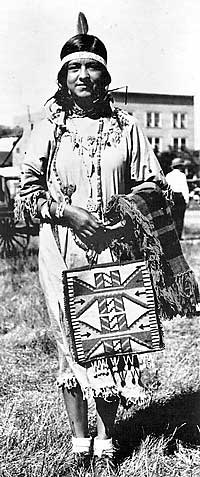|
|
Canku Ota |
|
|
(Many Paths) |
||
|
An Online Newsletter Celebrating Native America |
||
|
January 11, 2003 - Issue 78 |
||
|
|
||
|
Hazel Pete Revived Interest in Art of Basket Weaving |
||
|
by Bradley Meacham Seattle
Times staff reporter
|
||
|
credits: Hazel Pete
posed for this picture after her high-school graduation in 1932. Photo
Chris Richardson.
|
 When
Hazel Pete was born in 1914, in a one-room house on the Chehalis Indian
Reservation, Native American art often took a back seat to survival.
Tribe members say poverty, alcoholism and shame about Indian culture
were problems that overshadowed traditions like basket weaving. When
Hazel Pete was born in 1914, in a one-room house on the Chehalis Indian
Reservation, Native American art often took a back seat to survival.
Tribe members say poverty, alcoholism and shame about Indian culture
were problems that overshadowed traditions like basket weaving.
As a result of Mrs. Pete's efforts, dozens of people are now creating baskets, an art form that enjoys renewed appreciation far beyond the borders of the reservation. She died on Jan. 2 of heart failure at her home near Oakville, Grays Harbor County. She was 88. "She revived the art," said Karen Reed-Squally, a basket maker in Puyallup who befriended Mrs. Pete while studying at the University of Washington. "You can't put a dollar value on the gift of knowledge she shared." Mrs. Pete was named a master artist in 1994 by the Washington State Arts Commission Folk Arts Program and was on the faculty at The Evergreen State College. In 1997 her image was added to the Clocktower Project at Centralia Community College, and in 2001 Gary Locke presented her with the Governor's Heritage Arts Award. She first learned how to weave baskets at age 5 by watching her grandmother. While attending Indian schools she was honored as a talented art student, and she attended the Institute of American Indian Arts in Santa Fe, N.M. She later taught throughout Oregon, California and Nevada before returning to Washington. "She taught how to collect the materials, and how to process — how to learn," Reed-Squally said. "That's the patience you learn from working with elders." Mrs. Pete developed a technique of making double-layered baskets, with woven cedar bark on the inside and dried grass on the outside. She also made baskets sewn with cattails, often containing the stylized image of a thunderbird. The Chehalis style includes geometric designs that are distinct from more widely known basket forms made by members of the coastal Nootka and Makah tribes, which are marked by images of whales and other animals, said Heidi Bohan, an expert on plants used in Native American baskets. "The symbolism of the designs is one of the most important characteristics," Bohan said. "The form she kept alive is unique in the world." Her baskets won top prize several years ago at a prominent Native American art contest in New Mexico. Perhaps her most important accomplishment, relatives and other artists say, was keeping knowledge of basket making alive. She taught at art exhibits and conferences, and she wove every day, making two baskets a day until recently. Last November, at age 88, she appeared at an event in the Nisqually Delta dressed to gather cattails for baskets. "She taught the art to anyone she could," said grandson Chris Richardson, a certified public accountant. "Everyone in the family had to collect cedar and cattails," Richardson said, recalling making baskets as a group. "It's a seasonal activity and a family activity. It's not an activity for a loner." More broadly, Mrs. Pete focused on encouraging Native Americans to finish school, emphasizing that learning was the only way to get ahead, according to "Within the Circle of the Rim," a book about Northwest artists. She taught the Chehalis language and pursued more education herself, earning a master's degree in education from the UW while in her 60s. She also founded a basketry institute on the Chehalis reservation to carry on the art. Mrs. Pete had 13 children. Surviving children are Janet Camp of Oklahoma; Curtis DuPuis of Oakville; Yvonne Peterson of Skokomish; Trudy Marcellay of Oakville; Henrietta Boyd of Rochester, Thurston County; Donna DuPuis of Oakville; and David DuPuis of Rochester, Richardson said. Six children and two husbands, Joseph DuPuis and Frank Richardson, died previously.
|
|
|
||
|
|
||
| Canku Ota is a free Newsletter celebrating Native America, its traditions and accomplishments . We do not provide subscriber or visitor names to anyone. Some articles presented in Canku Ota may contain copyright material. We have received appropriate permissions for republishing any articles. Material appearing here is distributed without profit or monetary gain to those who have expressed an interest. This is in accordance with Title 17 U.S.C. section 107. | ||
|
Canku Ota is a copyright © 2000, 2001, 2002, 2003 of Vicki Lockard and Paul Barry. |
||
 |
 |
|
|
The "Canku Ota - A Newsletter Celebrating Native America" web site and its design is the |
||
|
Copyright © 1999, 2000, 2001, 2002, 2003 of Paul C. Barry. |
||
|
All Rights Reserved. |
||
